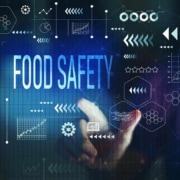Review of EU Novel Food submissions and US GRAS Petitions to identify opportunities for use of New Approach Methodologies for safety determinations of food substances
The IAFNS Food and Chemical Safety Committee is pleased to announce it is accepting applications for the above project. The risk assessment of some food substances have been shifting to adoption of a high-throughput, non-animal method strategy for demonstrating safety. These methods, along with new in vitro, in silico and powerful computer modeling tools, are collectively referred to as New Approach Methodologies or NAMs. This proposal seeks to review available safety assessments of food substances to identify classes of food substances that have leveraged NAMs data to support a regulatory approval. This would include a review of safety determinations by the U.S. Food & Drug Administration in its publicly available GRAS database, as well as those from the European Food Safety Authority.
Due date and address information: Proposals are due Oct. 10, 2023. The full Request for Proposals is available here.
Responses can be sent to IAFNS Senior Science Program Manager Neal Saab, PhD, at nsaab@IAFNS.org
Heavy Metals in US Foods: Exposure Assessment by Age Group and Mitigation Strategies
Heavy metals such as arsenic (As), cadmium (Cd), lead (Pb), and mercury (Hg) have the potential to cause neurocognitive impairment to infants and young children who are exposed to them in their diets. These elements can also cause chronic toxicological effects in older children and adults. To help address these risks it is important to identify which foods contain the highest levels of these metals; and based on US consumption of these foods by age group, which food-metal combinations cause the greatest potential exposure via diets. This research will examine which foods contain the highest levels of heavy metals; and based on US consumption of these foods by different age groups, which food-metal dyads cause the greatest human exposures. The researchers will then explore mitigation strategies to reduce these most severe exposures. Feasibility and cost-effectiveness of the strategies must be assessed to provide a realistic picture of what we can achieve in the short term to quickly lower exposures.
Institution: Michigan State University
Principal Investigator: Felicia Wu, PhD.
Date Awarded: May 5, 2022
Read more: Dietary Exposure to Cadmium from Six Common Foods in the United States.
This project is supported by the IAFNS Food and Chemical Safety Committee.
A Framework for Heavy Metal Prioritization and Mitigation for Reducing Metal Intake: Rice and Spinach Case Studies
Rice is a significant source of arsenic and other elemental toxins (e.g. mercury and cadmium) to the human diet, particularly in foods for babies and young children. Spinach is a significant source of the highly toxic metals Cd and Pb as well as other chemicals with negative health implications (e.g., organics, perchlorate), but the processes that lead to levels of concern in spinach differ from those in rice. This project will aim to design an adaptive, multi-part scoring system as the basis for prioritization of mitigation factors. This system will account for differences in commodities, metal combinations, soil-plant interactions and geochemistry, processing methods, and impact of these terms on the mean and variability of the metal concentrations of interest. This method should assess approaches to mitigation, helping prioritize methods that are both effective and achievable. In both risk and mitigation assessments, results will highlight research gaps, new research and action priorities, and propose a ranked and detailed set of proposed solutions.
Institution: University of Arkansas
Principal Investigator: Benjamin Runkle, PhD
Date Awarded: April 13, 2022
This research is supported by the IAFNS Food and Chemical Safety Committee.
Advancing Exposure Assessment for Food Contaminants Through Implementation of Probabilistic Modeling
Risk assessments for foods, ingredients and additives have evolved over the past few decades to incorporate new techniques such as benchmark dose modeling, and to further develop the utility of tools such as the threshold of toxicological concern, and even to explore advancements in carcinogen risk assessment. However, exposure assessments still tend to rely on deterministic approaches utilizing conservative inputs. Deterministic assessments are easy to conduct and easy to interpret; however, as point estimates of exposure, they do not account for variability in the level and/or likelihood of occurrence of a chemical or population differences in exposure inputs. Probabilistic assessments can further refine deterministic assessments using distributions for various exposure inputs and, as such, better account for exposure uncertainty. This project will survey the current state of adoption of probabilistic exposure modeling by regulatory agencies to inform risk management decisions and regulations for food contaminants, develop criteria for determining high quality distributions for input variables, and highlight the value of further integration of probabilistic exposure assessments into regulatory frameworks, including a discussion of factors that hinder widespread adoption.
Institution: Risk Science International
Principal Investigator: Greg Paoli, Principal Risk Scientist
Year Awarded: 2021
This work is supported by the IAFNS Food and Chemical Safety Committee.
Development of a Research Framework for Evidence-Based Assessment of Potential Carcinogens in Human Diets
Risk assessment of chemicals that are potentially carcinogenic in humans often relies on extrapolation from carcinogenicity bioassays. There is a growing belief in the scientific community that evidence-based risk assessment can replace historical, over-protective guidance-based approaches. However, there is no consensus within the scientific community on an approach or framework for the application of an evidence-based risk assessment. This project will develop such an approach by, first, categorizing potential exposure and mode of action scenarios leading to a carcinogenic response, followed by development of a framework based on sectoral examples such as hepatically activated electrophiles that are potential genotoxic carcinogens.
Institution: Cardno ChemRisk
Principal Investigator: Andrew Maier, PhD, DABT
Year Awarded: 2020
This project is supported by the IAFNS Food and Chemical Safety Committee.
Updating the Metal Dietary Exposure Screening Tool
The IAFNS Food and Chemical Safety Committee invests in the training and education of future scientists and leaders in the fields of food and chemical safety and food toxicology by supporting a Summer Fellowship Program for doctoral students. This project focuses on updating the Metal Dietary Exposure Screening Tool.
Detection of heavy metals at trace levels in foods and food ingredients is common given the unavoidable presence of metals in nature coupled with advancement in analytical methods and lower detection limits. In 2015, the Heavy Metal Subcommittee of the IAFNS Food and Chemical Safety Committee sponsored the development of a Metal Dietary Exposure Screening Tool and publication of the paper titled “Partitioning of Dietary Metal Intake—A Metal Dietary Exposure Screening Tool”. The tool provides a screening-level approach that serves as a first step in a tiered risk assessment process to evaluate potential public health risks when confronted with the detection of select heavy metals in foods and food ingredients. IAFNS and the Joint Institute for Food Safety and Applied Nutrition (JIFSAN) have agreed to collaborate on the continued development and biennial updating of the Metal Dietary Exposure Screening tool.
Institution: University of Rochester
Summer Fellow: Candace Wong, PhD Candidate
Year Awarded: 2019
Access the Metal Dietary Exposure Screening Tool.
Read more: Review of Regulatory Reference Values and Background Levels for Heavy Metals in the Human Diet
Learn more about the IAFNS Food and Chemical Safety Committee.
Assessing Human Health Impacts of Global Adoption of Codex Deoxynivalenol (DON) Guidelines
Due to climate change, there has been an increase in occurrence of mycotoxins in food and food ingredients. Multiple strategies have been developed to reduce mycotoxin risks before harvest (in the field), after harvest (in storage, transportation, or processing), and in diets. Developed nations have stricter limits for mycotoxins as compared to developing nations. Strict mycotoxin standards mean that developing nations will export their best quality foods and keep more heavily contaminated foods for domestic consumption, resulting in higher mycotoxin exposure in developing countries. Using Deoxynivalenol (DON, vomitoxin) as a case study, this research project will shed light on the potential human health impacts of the new Codex DON regulations on wheat trade worldwide.
Institution: Michigan State University
Principal Investigator: Felicia Wu, PhD
Year Awarded: 2018
Learn more about the IAFNS Food and Chemical Safety Committee.
Evaluation of the Dose-Response for Peanut Allergen
Due to the potentially severe nature of the response and absence of approved treatments, allergic individuals have been advised to avoid the food of concern, and food allergens must be included in the ingredients lists of packaged food. However, with statements such as "may contain allergen X" or "also packaged in a facility that contains allergen Y," it is difficult for consumers, food manufacturers and public health authorities to understand and manage the potential risk of exposures in the food supply. The 2016 National Academy of Sciences Report on Food Allergies provided a series of recommendations, including that regulatory agencies adopt a risk-based approach to identify threshold-based RfDs (Reference Doses) for food allergens. The aim of this project is to to use available data from controlled clinical trials of peanut allergen to conduct a risk-based dose-response analysis to enable establishment of RfDs for peanut allergen.
Institution: University of Cincinnati
Principal Investigator: Lynne Haber, PhD
Year Awarded: 2017
View this project on the Center for Open Science's Open Science Framework.
Learn more about the IAFNS Food and Chemical Safety Committee.








